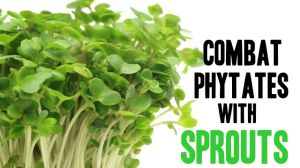
Many of the foods we consume on a daily basis are actually the reproductive unit of an organism. Grains, seeds, nuts and legumes are all the “baby” of the plant, put forth into the world to propagate that particular species.
Like a chicken’s egg with its shell, plant babies also have protective mechanisms in place to help them survive and reproduce. In the case of plant foods, the protective mechanisms are obviously not active or physical, but rather chemical.
They are substances that encase the seed so that, even if the seed gets eaten, it can survive the digestive process without sprouting prematurely. It can remain relatively whole with enough genetic information intact so that it can come out the other side pre-fertilized and ready to grow.
This is pretty clever and effective for the plant, but not so great for us humans, who want to gain nutrition from the plentiful species of grains, seeds, nuts and legumes. The chemical layers protecting plant babies can wreak havoc on our digestive systems, causing inflammation and malabsorption.
Phytates, for example, bind up minerals such as calcium and zinc. This can leave us deficient, causing problems such as tooth decay and poor skin and nail condition.
Lectins are inflammatory molecules which are difficult to digest, and can be confused by the body as one of our own endogenous proteins. This can set off an autoimmune response.
Grains and seeds also contain enzyme inhibitors to keep them from getting digested. They actually turn off the production of digestive enzymes in our saliva and digestive system so that we can’t break down the grain.
We can help remove some of these harmful substances with traditional preparation processes that mimic nature and coax the seed into sprouting. This way, we can help the nutrients from grains become more available to our human digestive system.
 According to the Weston A. Price Foundation, “Animals that nourish themselves primarily on grain and other plant matter have as many as four stomachs. Their intestines are longer, as is the entire digestion transit time.
According to the Weston A. Price Foundation, “Animals that nourish themselves primarily on grain and other plant matter have as many as four stomachs. Their intestines are longer, as is the entire digestion transit time.
Man, on the other hand, has but one stomach and a much shorter intestine compared to herbivorous animals. These features of his anatomy allow him to pass animal products before they putrefy in the gut but make him less well adapted to a diet high in grains—unless, of course, he prepares them properly.
When grains are properly prepared through soaking, sprouting or sour leavening, the friendly bacteria of the microscopic world do some of our digesting for us in a container, just as these same lactobacilli do their work in the first and second stomachs of the herbivores.”
Here are some simple steps for soaking and sprouting grains, seeds, nuts and legumes. If you want to learn more about this important time-honoured skill, Nourishing Traditions by Sally Fallon Morell is an excellent resource.
Soaking phase
1. Place your grains in a jar and add twice the amount of filtered water.
2. Add 1–2 tbsp of raw apple cider vinegar. The acid helps break down anti-nutrient compounds, and the probiotics help to slightly ferment the grains.
3. Leave them soaking for 4–12 hours, depending on the type. Lentils take 5 hours, chickpeas take 12 hours, barley takes about 8 hours.
4. At this point you can cook and consume, or if you want to make your grains even more digestible, continue with this process to allow them to sprout.
Sprouting phase
5. Drain the water and leave the jar sitting at an angle with some cheesecloth secured over the top with an elastic band.
6. Twice a day, fill up the jar, swirl the grains, then drain again. This creates a humid environment similar to the “spring thaw,” telling the seed that it’s time to sprout.
7. In 1–4 days your sprouts will have grown a short “tail” and will be ready to eat. Rinse them with vinegar and/or grapefruit seed oil to take care of any potential food contaminants before consuming. You can cook them or eat them raw. Store them in the fridge and eat within 3 days.
Now you know how to increase the nutrient availability of your grains, seeds, nuts and legumes. Your digestive system will thank you for feeding it healthy, living foods. Happy sprouting!
-The Alternative Daily
Sources:
http://thepaleodiet.com/beans-and-legumes-are-they-paleo
http://chriskresser.com/another-reason-you-shouldnt-go-nuts-on-nuts
http://journals.cambridge.org/action/displayAbstract?fromPage=online&aid=879124&fileId=S0007114598001081
http://wellnessmama.com/3807/sprouted-soaked-fermented-grains-healthy
http://nutritionstripped.com/guide-to-soaking-and-sprouting
http://onlinelibrary.wiley.com/doi/10.1111/j.1365-2621.1990.tb05261.x/abstract
http://www.westonaprice.org/health-topics/be-kind-to-your-grains-and-your-grains-will-be-kind-to-you
http://www.ncbi.nlm.nih.gov/pubmed/22878393

